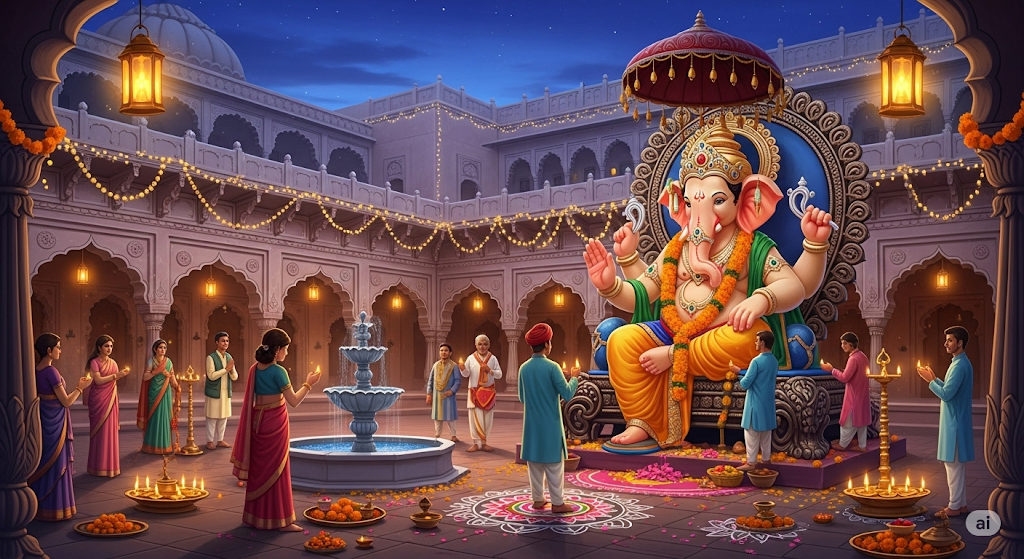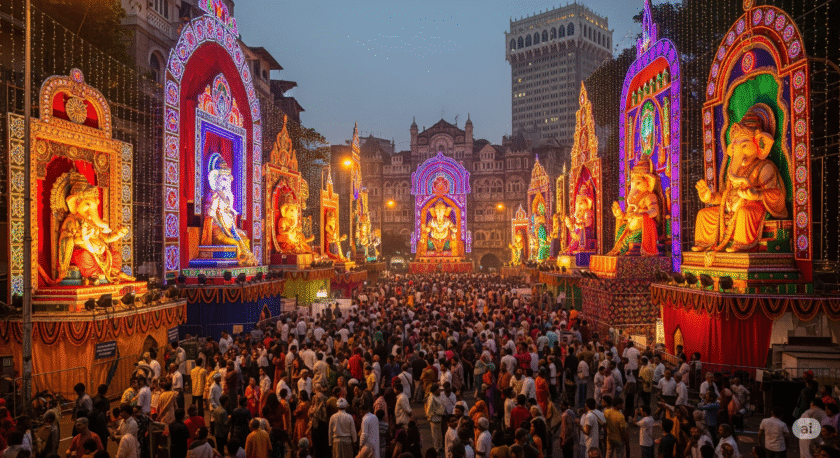Lucknow: In the heart of Uttar Pradesh, where the grandeur of Mughal architecture meets the vibrancy of modern Indian life, Lucknow has long been a cultural melting pot. Known for its poetic Urdu heritage, succulent kebabs, and intricate chikankari embroidery, the city has increasingly embraced festivals that blend tradition with contemporary flair. Among these, Ganeshotsav—the ten-day celebration honoring Lord Ganesha, the beloved elephant-headed deity and remover of obstacles—has emerged as a standout event. While deeply rooted in Maharashtra’s Marathi community, Ganeshotsav in Lucknow has transcended its origins over the past decade, evolving into a city-wide spectacle that unites diverse groups, boosts local economies, and adapts to urban realities.
The Roots of Ganeshotsav in Lucknow: A Marathi Enclave in Awadh
Lucknow’s tryst with Ganeshotsav began in the early 20th century, tied to the influx of Marathi migrants who settled in the city. The British colonial era’s administrative and industrial hubs, particularly the railways and government offices, attracted a significant number of workers from Mumbai and Pune. These families brought their devotion to Bappa, as Lord Ganesha is affectionately called, with them. The first organized Ganeshotsav in Lucknow is traced back to the 1920s, when small pandals (temporary shrines) were set up in areas like Alambagh and Mahanagar by Marathi associations.
In those early days, the celebrations were modest, intimate affairs. Families would install small clay idols at home, while community groups would gather in neighborhood halls for daily aartis (prayers). Inspired by the socio-political movement championed by freedom fighter Bal Gangadhar Tilak, who transformed a private festival into a public one in 1893 to unite people against British rule, Lucknow’s celebrations initially focused on fostering a sense of community. However, they remained largely confined to Marathi pockets, with limited participation from the city’s predominantly Awadhi population. It was a beautiful, but relatively quiet, ritual that existed on the city’s periphery. In the 2000s, as Lucknow urbanized rapidly, these events started gaining visibility, but it was the decade from 2013 to 2023 that truly catalyzed their explosive, city-wide growth.

The Decade of Transformation: From Niche to Citywide Phenomenon (2013–2023)
Over the last ten years, Ganeshotsav in Lucknow has ballooned from a handful of localized events to over 500 registered public pandals across the city, drawing lakhs of devotees and tourists annually. This evolution can be segmented into distinct phases, marked by key milestones, social shifts, and external influences.
2013–2015: Seeds of Expansion Amid Urban Boom
The early 2010s saw Lucknow’s urban landscape undergo a dramatic transformation. With the city’s population surging due to internal migration and a burgeoning economy, driven by new IT parks, malls, and real estate developments, the social fabric became more diverse. This provided a fertile ground for Ganeshotsav’s expansion. In 2013, the Lucknow Marathi Mandal organized what was then the largest public pandal in Gomti Nagar, a rapidly developing residential and commercial area. This event, which attracted approximately 50,000 visitors, became a landmark moment. It was a microcosm of what was to come, featuring traditional modak (sweet dumplings) distributions and cultural programs that successfully blended traditional Marathi folk dances with popular Bollywood hits.
By 2015, the burgeoning influence of social media platforms like Facebook and WhatsApp began to amplify these celebrations. Young organizers and devotees started sharing live updates, photos, and videos, turning personal devotion into a shared, viral spectacle. This digital amplification played a crucial role, as people outside the Marathi community discovered the festival’s vibrant energy and inclusive ethos, leading to a significant increase in non-Marathi participation. However, this initial growth also brought new challenges: the sheer volume of attendees led to issues like traffic congestion and nascent environmental concerns over idol immersions, foreshadowing the need for a more structured, adaptable approach.
2016–2019: Commercialization and Cultural Fusion
The mid-decade marked a significant shift toward grandeur and strategic inclusivity. In 2016, the Uttar Pradesh government, recognizing the festival’s tourism potential, began offering support and encouragement. This public-private partnership spurred pandal committees to invest in more elaborate and creative decorations. The pandals transformed into magnificent structures adorned with mesmerizing LED lights and themed installations, often inspired by popular Bollywood movies or social messages like the “Swachh Bharat” (Clean India) campaign. The Sarvodaya Nagar pandal, for instance, became a crowd favorite, hosting a spectacular eco-friendly clay idol that drew crowds comparable to Mumbai’s famous Lalbaugcha Raja.
This period saw the festival’s strong commercialization. Local businesses poured money into sponsorships, which in turn funded grander events. The streets surrounding the pandals became bustling marketplaces, with food stalls selling a fascinating array of fusion cuisine. Here, you could find Maharashtrian vada pav and poha being sold next to Lucknow’s famed Awadhi biryani and chaat. By 2018, it was estimated that Ganeshotsav contributed an estimated Rs 50 crore to the local economy, generating jobs for artisans, vendors, and event managers. Culturally, the festival evolved to include non-Marathi elements, with qawwali performances sharing the stage with lavani dances, a true reflection of Lucknow’s syncretic Ganga-Jamuni tehzeeb. Women’s participation also surged, with self-help groups crafting idols and selling festive items, empowering local economies and reinforcing the festival’s inclusive nature.
However, this period wasn’t without its challenges. In 2017, debates over noise pollution from the popular DJ nights and loud music led to stricter regulations, forcing organizers to find a better balance between boisterous festivity and civic harmony.
2020–2023: Pandemic Resilience and Digital Innovation
The COVID-19 pandemic, which began in 2020, presented the ultimate test of Ganeshotsav’s adaptability. With strict lockdowns and social distancing measures in place, the grand physical pandals were largely scaled back. But the festival, a testament to its devotees’ resilience, simply went digital. Livestreamed aartis on platforms like YouTube and Facebook Live allowed people to participate in the prayers from the safety of their homes, reaching global audiences, including the Indian diaspora. While idol sales initially dipped, the demand for home-based worship rebounded, with smaller, eco-friendly idols becoming a popular choice. By 2021, as restrictions eased, hybrid events emerged, with smaller pandals offering online bookings for darshan (viewing the idol) to manage crowds.

Post-pandemic, the festival roared back with a renewed vigor in 2022. Lucknow hosted its first “Ganeshotsav Expo,” a large-scale event showcasing the work of idol artisans and drawing an impressive 2 lakh visitors. This period also saw a peak in environmental consciousness. The Lucknow Municipal Corporation mandated that idols must be made from natural clay and dyes, setting up designated pits and artificial tanks for immersion to reduce pollution in the Gomti River. Digital tools became even more sophisticated, with apps providing pandal maps, real-time crowd updates, and donation portals, truly modernizing the age-old experience. By 2023, Ganeshotsav had become a permanent and unmissable fixture on Lucknow’s festival calendar, its scale and vibrancy now rivaling that of Diwali.
Key Drivers of Evolution: Why Has Ganeshotsav Blossomed in Lucknow?
The decade-long transformation of Ganeshotsav is not accidental; it is the result of several interconnected factors that have converged to create a unique and powerful cultural phenomenon.
Demographic Shifts and Inclusivity
Lucknow’s population grew from 2.8 million in 2011 to an estimated 3.5 million by 2023. This increase, fueled by both internal migration and a rising birth rate, brought more people from Maharashtra and other states to the city. While this provided a natural demographic base for the festival, its widespread appeal broadened due to its universal themes of prosperity and obstacle-removal, which resonate across all communities. The presence of interfaith participation, such as Muslim artisans crafting Ganesha idols, underscores the city’s famed Ganga-Jamuni tehzeeb (a poetic term for Hindu-Muslim syncretism), making Ganeshotsav a truly inclusive event.
Economic and Technological Boost
Rising disposable incomes among Lucknow’s middle class allowed pandal committees to invest in more lavish and technologically advanced setups. E-commerce platforms made the procurement of idols and decorative items easier and more accessible than ever before. Social media transformed organizers into influencers, with hashtags like #LucknowGanpati garnering millions of views and turning local celebrations into national trends. The festival now generates a robust economy, with the demand for idol-making, decoration, event management, and vendor services creating thousands of seasonal jobs.
Policy and Environmental Awareness
The positive stance of the state government and local authorities has been crucial. Initiatives like traffic management plans and subsidies for eco-friendly idols have sustained the festival’s growth. NGOs like the Gomti River Revival Project have partnered with the government to promote sustainable practices, ensuring that the festival aligns with global green movements. The introduction of designated immersion tanks and mandatory guidelines has helped to reduce the environmental footprint, demonstrating a responsible approach to a grand tradition.
Cultural Globalization
Exposure to the grand, immersive Ganeshotsav celebrations of Mumbai and Pune via television, movies, and travel has inspired Lucknowites to replicate that scale and dynamism. However, Lucknow has made the festival its own by integrating local flavors—such as the aforementioned Awadhi cuisine and local folk music—making it uniquely “Lucknowi.”
The Future of Ganeshotsav in Lucknow: Sustaining the Momentum
As Ganeshotsav enters its next decade, Lucknow’s celebration stands as a powerful testament to cultural resilience and adaptation. What began as a quiet Marathi ritual has morphed into a vibrant, inclusive, and technologically savvy festival that mirrors the city’s own cosmopolitan ethos. From modest home shrines to dazzling urban spectacles, its evolution reflects broader Indian trends: digitization, sustainability, and communal harmony.
For visitors and residents alike, it’s more than a festival—it’s an immersion into Lucknow’s soul, where devotion dances with diversity. Whether you’re savoring a plate of Ganpati-special chaat or witnessing the grand visarjan procession along the Gomti, Ganeshotsav promises obstacle-free joy for all. As Bappa’s benevolent trunk blesses the city, one can’t help but wonder: in this ever-evolving tapestry, what new traditions will emerge next?





